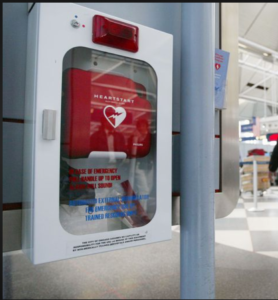In writing this last post as a junior blogger, I decided to highlight the tremendous efforts by the American Heart Association (AHA) to improve cardiovascular care in the field of cardiac arrest and cardiopulmonary resuscitation (CPR). As we know, the AHA is a worldwide leader in first aid, CPR, and Automated External Defibrillator (AED) training – educating millions of people globally in CPR every year. Here, I will share some fun facts about CPR, and you can refer to the AHA website for further details about this important topic.
Important CPR statistics
- Majority of cardiac arrests occur outside of the hospital, with estimated 475,000 Americans dying from cardiac arrests every year [1]
- Bystander CPR is a key component in the out-of-hospital “chain of survival” [Figure 1] and studies have shown it improves survival in cardiac arrest [1-3].

Figure 1: The adult out-of-hospital “chain of survival”. Each link of the chain from left to right is numbered 1 through 5: 1- Recognize cardiac arrest and activate the emergency response system, 2- early CPR with high-quality chest compressions, 3- Use AED for rapid defibrillation, 4- basic and advanced emergency services and 5- post-cardiac arrest care and advanced life support [2].
- Bystander CPR has been increasing over the recent years in both men and women. Despite that, survival improved in men only, but not women [2]. This is important as it highlights that more work is needed to identify additional predictors of survival in women with cardiac arrest.
- Efforts mandating CPR training in high schools in multiple states [5] and availability of AED in public places, including airports [Figure 2], have helped in increasing the awareness and familiarity of bystander CPR in cardiac arrest [4].

- Figure 2: A photo of Automated External Defibrillator (AED) in one of the airports.
Personal Experience
From a personal experience, I have visited multiple high schools in my home country as well as in the United States, and have participated as an organizer in the sessions teaching high school students how to perform effective CPR. It is inspiring to see junior students interested in learning and saving lives. The takeaway from my experience is that engagement plays a major role in spreading the word and encouraging the general public to take the extra step and learn how to perform basic and advanced life support techniques.
In conclusion, it is important to remember that the general public are oftentimes our first “link” in the chain of survival; making them an important part of our efforts to improve survival and cardiovascular care in patients with cardiac arrest. A strong chain of survival improves survival and recovery after cardiac arrest. Although there have been improvements in CPR and advanced life support, there remains room for further improvement, and perhaps we can do our part by encouraging our patients, friends and relatives to take the first step and learn how to perform effective CPR and possibly how to use AEDs!!
I have added a few online references for those interested in sharing this with their patients and encouraging them to sign up for both the online and class programs [3,6]!!
References:
- Meaney PA, Bobrow BJ, Mancini ME, et al. Cardiopulmonary resuscitation quality: [corrected] improving cardiac resuscitation outcomes both inside and outside the hospital: a consensus statement from the American Heart Association [published correction appears in Circulation. 2013 Aug 20;128(8):e120] [published correction appears in Circulation. 2013 Nov 12;128(20):e408]. Circulation. 2013;128(4):417-435. doi:10.1161/CIR.0b013e31829d8654
- Malta Hansen C, Kragholm K, Dupre ME, et al. Association of Bystander and First-Responder Efforts and Outcomes According to Sex: Results From the North Carolina HeartRescue Statewide Quality Improvement Initiative. J Am Heart Assoc. 2018;7(18):e009873. doi:10.1161/JAHA.118.009873
- CPR facts and stats:
https://cpr.heart.org/en/resources/cpr-facts-and-stats
- Chain of Survival:
https://cpr.heart.org/en/resources/cpr-facts-and-stats/out-of-hospital-chain-of-survival
- Mandatory CPR training in high school:
https://www.sca-aware.org/schools/school-news/mandatory-cpr-training-in-us-high-schools
- CPR AED and first aid classes:
https://cpr.heart.org/en/course-catalog-search
“The views, opinions and positions expressed within this blog are those of the author(s) alone and do not represent those of the American Heart Association. The accuracy, completeness and validity of any statements made within this article are not guaranteed. We accept no liability for any errors, omissions or representations. The copyright of this content belongs to the author and any liability with regards to infringement of intellectual property rights remains with them. The Early Career Voice blog is not intended to provide medical advice or treatment. Only your healthcare provider can provide that. The American Heart Association recommends that you consult your healthcare provider regarding your personal health matters. If you think you are having a heart attack, stroke or another emergency, please call 911 immediately.”